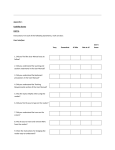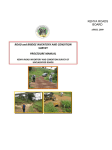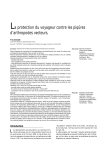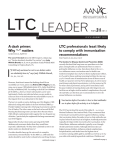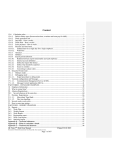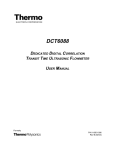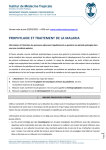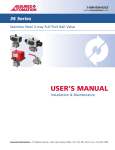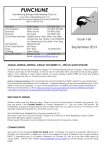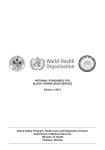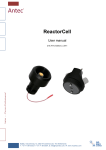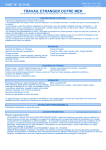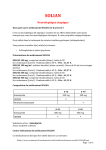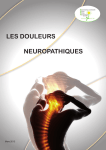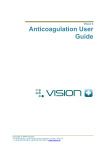Download Unit 9
Transcript
DIRECTORATE OF LEARNING SYSTEMS DISTANCE EDUCATION PROGRAMME COMMUNICABLE DISEASES COURSE Unit 9 Malaria Allan and Nesta Ferguson Trust Unit 9: Malaria A distance learning course of the Directorate of Learning Systems (AMREF) © 2007 African Medical Research Foundation (AMREF) This course is distributed under the Creative Common Attribution-Share Alike 3.0 license. Any part of this unit including the illustrations may be copied, reproduced or adapted to meet the needs of local health workers, for teaching purposes, provided proper citation is accorded AMREF. If you alter, transform, or build upon this work, you may distribute the resulting work only under the same, similar or a compatible license. AMREF would be grateful to learn how you are using this course and welcomes constructive comments and suggestions. Please address any correspondence to: The African Medical and Research Foundation (AMREF) Directorate of Learning Systems P O Box 27691 – 00506, Nairobi, Kenya Tel: +254 (20) 6993000 Fax: +254 (20) 609518 Email: [email protected] Website: www.amref.org Writer: Dr Beth Rapuoda Chief Editor: Anna Mwangi Cover design: Bruce Kynes Technical Co-ordinator: Joan Mutero The African Medical Research Foundation (AMREF wishes to acknowledge the contributions of the Commonwealth of Learning (COL) and the Allan and Nesta Ferguson Trust whose financial assistance made the development of this course possible. CONTENTS INTRODUCTION _________________________________________________________________ 1 SPECIFIC OBJECTIVES ............................................................................................................................. 1 SECTION 1: EPIDEMIOLOGICAL ZONES AND MODE OF TRANSMISSION_____________ 1 OCCURRENCE AND DISTRIBUTION OF MALARIA IN KENYA ................................................................ 3 Lakeside Endemic ................................................................................................................................ 4 Coastal Endemic .................................................................................................................................. 4 Highlands ............................................................................................................................................. 4 Arid, Seasonal ...................................................................................................................................... 4 Low Malaria Risk ................................................................................................................................ 5 LIFE CYCLE OF THE HUMAN MALARIA PARASITE ............................................................................... 6 SECTION 2: CLINICAL ASSESSMENT IN MALARIA _________________________________ 8 HISTORY TAKING .................................................................................................................................... 8 PHYSICAL EXAMINATION ....................................................................................................................... 9 General Physical Examination ............................................................................................................ 9 CLINICAL FEATURES .............................................................................................................................. 9 Uncomplicated Malaria ..................................................................................................................... 10 INVESTIGATIONS ................................................................................................................................... 12 Blood Slide ......................................................................................................................................... 12 White Blood Cell (WBC).................................................................................................................... 13 Blood Haemoglobin (Hb) Estimation ................................................................................................ 13 Urinalysis ........................................................................................................................................... 13 Blood Grouping ................................................................................................................................. 13 DIAGNOSIS ............................................................................................................................................. 13 MICROSCOPY......................................................................................................................................... 14 RAPID DIAGNOSTIC TESTS (RDTS) ..................................................................................................... 14 Special Storage Requirements ........................................................................................................... 16 SECTION 3:MANAGEMENT OF MALARIA _________________________________________ 20 PREVENTION .......................................................................................................................................... 21 Personal Prevention and Prevention in Pregnant Women ............................................................... 21 Malaria Prevention in the Community .............................................................................................. 23 TREATMENT .......................................................................................................................................... 24 Uncomplicated Malaria ..................................................................................................................... 24 Severe Malaria ................................................................................................................................... 26 Evaluation and Management of some Specific Clinical Manifestations of Severe and Complicated Malaria............................................................................................................................................... 27 CEREBRAL MALARIA ............................................................................................................................ 27 SEVERE ANAEMIA ................................................................................................................................. 27 HYPOGLYCEMIA.................................................................................................................................... 27 RENAL IMPAIRMENT ............................................................................................................................. 28 RESPIRATORY COMPLICATIONS .......................................................................................................... 28 OTHER COMPLICATIONS ...................................................................................................................... 28 CHRONIC COMPLICATIONS .................................................................................................................. 28 TREATMENT OF SEVERE AND |COMPLICATED MALARIA ................................................................. 29 SUPPORTIVE THERAPY ......................................................................................................................... 32 TUTOR MARKED ASSIGNMENT __________________ ERROR! BOOKMARK NOT DEFINED. i INTRODUCTION Welcome to Unit 9 of your course on communicable diseases. In the previous units you covered the basic concepts of communicable diseases, the epidemiological approaches and also disease surveillance and epidemics control. You also learnt about travel medicine in relation to communicable diseases, immunization, as well as the prevention and control of contact, vector-borne and sexually transmitted diseases. In this Unit we will focus on the concepts and principles applicable to the prevention and control of malaria. We expect that by the end of this unit you should be able to apply the infection prevention and control measures in protecting patients, health workers and the community in general from this diseases which can be deadly. Specific objectives .By the end of this unit you should be able to: Give a definition of malaria Describe the epidemiological zones in Kenya Describe the mode of transmission of malaria Make a clinical assessment of malaria Outline the treatment, prevention and control of malaria Discuss malaria in special circumstances such as pregnancy Now that you know what to expect in this Unit, let us start by looking into the epidemiology and mode of transmission of malaria. Section 1: Epidemiological Zones And Mode Of Transmission Malaria is an acute infection of the blood caused by the parasite Plasmodium, which is directly or indirectly responsible for much ill health and death. The malaria parasites are transmitted from one infected person to another by the bite of a female mosquito of the genus Anopheles. Only certain species of the anopheline mosquitoes, known as vectors or carriers of malaria, can transmit the parasite. Vectors of malaria in Kenya and our region are Anopheles gambiae sl and Anopheles funestus. But different Anopheles vectors are 1 involved in the transmission of malaria in other countries in Africa. Malaria remains a leading cause of morbidity and mortality, especially in children and pregnant women. It accounts for 30% of outpatient attendances and 19% of admissions to health facilities. The level of malaria endemicity varies regionally. Malaria is endemic in the humid low-lying areas of the coastal plains, around the shores of Lake Victoria and by the swamps of most rivers. These ecological zones are classified as high malaria risk areas. It is not so common in the highlands. When a malaria outbreak occurs in the highlands, it is referred to as “highland malaria” and the infection in these areas may also be caused by P. falciparum. The severe malaria condition usually experienced in the highlands is due to the lack of immunity among the inhabitants and the fact that all age groups are affected. The risks of an individual acquiring a malaria infection is dependent on the level of chance that he/she will come into contact with one of the principal mosquito vectors (An. gambiae sl or An. funestus) and that these vectors carry the malaria parasite P. falciparum. There are four types of Plasmodia species: falciparum, vivax, ovale and malariae. Of these Plasmodium falciparum is the commonest in Kenya and is known to cause severe and complicated malaria. Do you know the dynamics of malaria transmission? Try to make your own sketch on a piece of paper, and then compare what you have written with Figure 1. 2 Determinants of Malaria Parasite Mosquito Human Environment Transmission Infection Ilness Death Figure 1 Dynamics of Malaria transmission Occurrence and Distribution of Malaria in Kenya The level of endemicity of malaria in Kenya varies from region to region and there is a big diversity in risk largely driven by climate and temperature (including the effects of altitude). Based on malaria risk, districts in Kenya can be broadly categorized into one of five classes of malaria ecology (see Figure 2). We are now going to look in detail at each one of these categories 3 Lakeside Endemic Looking at the map on malaria transmission in Kenya, you see areas where malaria exists all the year round. These areas are known as malaria endemic areas. The Lakeside endemic area includes mainly districts close to Lake Victoria where malaria transmission is common every year. Here the community acquires immunity before adulthood and the risks of disease and death from malaria are concentrated amongst children and pregnant women. Transmission is perennial and the parasite prevalence amongst childhood communities often exceeds 50%. Coastal Endemic The Coast is similar in endemicity to the Lakeshore with parasite prevalence often exceeding 50%. However, the transmission and maximal disease risk period exhibit stronger seasonality and the intensity of transmission is lower towards the Somali border. There are also areas where malaria is only seasonal, generally soon after the rains. These are known as Epidemic areas. Highlands A common feature of malaria in highland districts is that whilst there is always a potential for limited transmission, lending itself to an overall low disease risk, on an average year, variations in rainfall and ambient temperatures between years can lead to epidemics affecting all members of the community. The parasite prevalence is low in these districts but varies widely over small spatial distances. Arid, Seasonal Several districts in a large part of North Eastern, North Western and Central areas of the country only experience malaria where communities are located close to water bodies. The arid intervals between rainfalls limit the transmission of parasites only to a few months of the year or transmission may even be absent on occasional low rainfall years. Other districts might experience transmission every year for a few months. Overall all districts in this category will support low infection prevalence rates in childhood. The last group is where there is no active transmission. 4 Low Malaria Risk These areas cover the highlands within Central Province and Nairobi province. Parasitological surveys in these areas on the whole suggest low parasite prevalence among children aged 0-14 years. Several areas will experience almost no malaria risk, for example the central areas of Nairobi, Nyeri and Nakuru. Take Note For clinical management purposes the ecological zones are classified into: 1. High malaria risk areas which include Lakeside, Coastal, Highland and arid areas 2. Low malaria risk areas which are the Highlands within Central Province Now check the map on Figure 2 and note whether the place that you are working at, is a malarial endemic or epidemic zone. 5 Figure 2: Endemicity of Malaria in Kenya (Courtesy Ministry of Health1) Life Cycle of the Human Malaria Parasite How is malaria transmitted? Try to draw your own illustration of the life cycle of the human malaria parasite. Then compare to figure 3. 6 Figure 3 : Life Cycle of the human Malaria Parasite (Courtesy of CDC) The malaria parasite life cycle involves two hosts. During a blood meal, a malariainfected female Anopheles mosquito inoculates sporozoites into the human host (1). Sporozoites infect liver cells (2) and mature into schizonts (3), which rupture and release merozoites (4). In P. vivax and P. ovale a dormant stage (hypnozoites) can persist in the liver and cause relapses by invading the bloodstream weeks, or even years later. After this initial replication in the liver (exo-erythrocytic schizogony (A), the parasites undergo asexual multiplication in the erythrocytes (erythrocytic schizogony (B). Merozoites infect red blood cells (5). The ring stage trophozoites mature into schizonts, which rupture releasing merozoites(6). Some parasites differentiate into sexual erythrocytic stages (gametocytes) (7). Blood stage parasites are responsible for the clinical manifestations of the disease. 7 The gametocytes, male (microgametocytes) and female (macrogametocytes), are ingested by an Anopheles mosquito during a blood meal(8). The parasites’ multiplication in the mosquito is known as the sporogonic cycle (C). While in the mosquito's stomach, the microgametes penetrate the macrogametes, generating zygotes(9). The zygotes in turn become motile and elongated (ookinetes) (10) which invade the midgut wall of the mosquito where they develop into oocysts (11). The oocysts grow, rupture, and release sporozoites (12), which make their way to the mosquito's salivary glands. Inoculation of the sporozoites into a new human host perpetuates the malaria life cycle (1). Section 2: Clinical Assessment In Malaria Clinical assessment is the process that you should follow in order to make a correct diagnosis of malaria. Before you read any further, take a piece of paper and write down the three steps in clinical assessment. Then, compare your answers to what is written below. History Taking Step 1 is history taking. This is the systematic inquiry into the patient’s life in relation to the illness by obtaining relevant information from the patient or the patient’s caretaker for the purpose of making diagnosis. The medical history includes: Identification data (Name, Sex, Ethnicity, Religion, Next of Kin, Residential Address and date of visit in the health unit) Presenting complaint (The problem causing the patient to come for medical attention) History of the presenting complaint (When it started, how it started, was the onset sudden or slow and what was the sequence of occurrence) Past Medical History Ask whether the patient has had the same illness before, any other past illness, whether the patient has been admitted or has chronic illness 8 Treatment History Ask the patient what other treatments have been taken during the present illness and history of drug allergy Family social history Ask if any one else is sick, general health of other family members, if mother and father are alive, if the condition runs in the family, sanitary conditions. Physical Examination This is a procedure carried out by a health worker on a patient in order to assess the physical state of the patient’s body. Physical examination includes: Inspection: to look and see Palpation: Touch and feel Percussion: Use the middle fingers of both hands to elicit resonance sounds in cavities like the thorax and abdomen. Auscultation: Use a stethoscope to detect sounds in the thorax and abdominal cavities. The same is used for detecting bruits (sound or murmur ,especially an abnormal one), such as with the brachial pulse when taking blood pressure (BP). Physical examinations are divided into two main types: General Physical examination Systemic physical examination General Physical Examination In patients with malaria check the vital signs such as temperature, blood pressure, pulse rate and respiratory rate. Observe also if there is jaundice, goose skin appearance, pall of varying degrees, loss of skin turgor, dryness of mucous membrane or absence of tears. Clinical Features Although it is not necessary to memorize the transmission cycle of malaria, it is good to go back to Figure 3 and revise it once again, as this will help you to understand why malaria presents itself the way it does. Malaria can present in the following ways: 9 Uncomplicated Malaria This is the most common presentation of malaria and is usually seen in people living in malaria endemic areas. This is usually characterized by fever in the presence of peripheral parasitaemia. List down any other features that you know of, then compare how many of the features given below you have in your list. Other features may include: Headache Chills Profuse sweating Muscle pains Joint pains Nausea, vomiting and diarrhoea Irritability and refusal to feed Other findings are mild anaemia and or splenic enlargement. Take Note These features may occur singly or in combination. 10 Malaria Outpatient Algorithm for Older Children (>5 Yrs) and Adults FEVER Assess patient for clinical signs of severe malaria If No signs of severe malaria is there any other cause of fever? a) Sore throat or runny nose? b) Frequent or painful urination? c) Soft tissue infection or abscess? d) any other identifiable cause of fever? If No to all & microscopy/ RDT not available Treat for malaria: Artemether-lumefantrine or quinine if pregnant If No to all & microscopy/RDT available Request blood slide/RDT Treat for malaria:AL or Quinine if pregnant If Yes to any regardless availability of microscopy/RD Do not request blood slide/RDT Do not treat for malaria: Treat symptoms Do not treat for malaria Treat other cause of fever Provide COUNSELLING Provide advice on FOLLOW-UP Figure4: Malaria Outpatient Algorithm for Older Children (>5 Yrs) and Adults 11 Investigations In the case of malaria, taking the patient’s history and conducting a physical examination may not be enough to help a diagnosis. It may be necessary to confirm your findings with some investigations, especially where these facilities are present. Laboratory investigations can range from a simple laboratory procedure to radiological and other complex procedures. A medical laboratory investigation is a procedure done on a specimen in order to confirm or exclude the presence of a disease. In humans, the specimens that are commonly investigated include: Blood Urine Sputum Stool Pus Urethral or vaginal discharge Biopsy specimens, etc The following Investigations should be done on a patient who presents with signs and symptoms of malaria. Blood Slide There are two types of blood slides: Thick blood slide (film) – for screening of malaria parasites Thin blood slide film – is for identification of various species of Malaria parasites A blood slide helps you to do the following: Confirm or exclude malaria Follow up treatment for malaria Screen donated blood for malaria Screen for other haemoparasites Confirm type of anaemia 12 White Blood Cell (WBC) Total and differential counts may be ordered for: P.U.O (Pyrexia of unknown origin) Lymphocyte count Leukaemia Remember, these are some of the conditions that present with fever. Blood Haemoglobin (Hb) Estimation To diagnose anaemia Screening for anaemia To monitor and follow up during treatment for anaemia Take Note Malaria is one of the most common causes of anaemia .including severe anaemia. Urinalysis The reason for carrying out urinalysis is to exclude urinary tract infection as a cause of fever and also for haemoglobinuria as in malaria. Blood Grouping This may be ordered before blood transfusion. Diagnosis Fever in both adults and children is quite common and can have many causes. Often in our malarial areas, most of these other causes are missed and all fevers are treated as malaria. 13 1. What are the diseases that are often confused with malaria in your centre? 2. How do you normally make sure that the case is one of malaria and not something else? 3. How do you normally make sure that the case is one of malaria and not one of the above? Microscopy Microscopy is the gold standard for the diagnosis of malaria parasites in the peripheral blood of the patient. Demonstration of malaria parasites can easily be done by obtaining thick and or thin blood slides from the patient. The thick blood slides can then be stained using Field’s stain or Giemsa. The slides are then mounted under a microscope with oil immersion with lens x100 and ring forms of the parasites can then be counted. The thin slides should be fixed using methanol then stained with Giemsa. When using a Leishman stain, fixing is not required. The thin slide is more reliable because the parasitaemia can be estimated and also the red cell morphology can be seen. The advantages of microscopy include its low cost, high sensitivity and specificity when used by well-trained staff. Rapid Diagnostic Tests (RDTs) Rapid diagnostic kits (RDTs) have been developed for malaria diagnosis. The implementation of the new drug policy of ACTs requires that all suspected cases of malaria should be confirmed. In view of the limited laboratory services in rural health facilities, the use of RDTs is necessary so as to complement the use of microscopy. Principle / Purpose of RDTs RDTs are used for the identification or exposure to malaria parasites by the detection of antibodies, parasite antigens, parasitic metabolic products or parasite enzymes. They usually use immune-chromatographic methods performed on lysed blood containing antigens/antibodies and other parasites metabolic products. 14 What are RDTs? Malaria rapid diagnostic tests, or RDTs, detect antigens (proteins) produced by malaria parasites. These antigens are present in the blood of infected or recently infected people. To detect the antigens, RDTs indicate infection by use of immunochromatography (lateral flow of an antigen or antibody) that is, the protein produced by a person in response to an antigen, in a filter paper resulting in a colour change. Some RDTs detect only one species of malaria, and some detect one or more species. The tests come in different formats: dipstick, cassette, or card. We’ll look at an example of a cassette test that detects an infection with Plasmodium falciparum. Why are RDTs being used? RDTs have become quite common because they are simple and fast. Now that new treatment policy guidelines recommend parasitological diagnosis of malaria, especially for older children (>5 years) and adults in malaria high risk areas and for all age groups in low malaria risk areas, it is important to have a test that is easy to use and can give results quickly. Are the results obtained by RDTs accurate? 15 Yes. RDTs are sensitive in detecting parastaemia. When tests are in good condition, some of them can achieve sensitivity similar to that commonly achieved by microscopy (looking at blood smears under a microscope). Take Note When a parasitological test is needed, RDTs are NOT entirely interchangeable with a blood smear. RDTs ARE NOT recommended for: Follow-up of patients who have been treated for malaria since most tests remain positive for up to 2 weeks following effective anti-malarial treatment. Determination of parasite density. These test are NOT quantitative. RDTs cannot be stored for reference. The results are unreliable beyond the manufacturer’s recommended time for reading, e.g. 15-20 minutes, depending on the test. Special Storage Requirements Prior to use, boxes containing RDTs should be stored in the least humid, coolest place in the facility. The storage site should be clean and as dry as possible. Used RDTs should be disposed of as soon as the results have been interpreted and recorded since the results shown on the test cassette are unreliable beyond the recommended time for reading. How does an RDT work? 16 The test cassette contains a strip with antibodies against malaria parasite. When blood is added, it flows along the strip. If malaria parasite antigens are present, two bands are formed: a control band and a positive test band. In the absence of malaria parasite antigens, only the control band is formed. The test kit may contain some of the following materials: Instruction sheet (package insert) Packaged cassettes Blood collection devices (micropipettes or micro-capillary tubes) Reagent buffer Swabs (70% alcohol, cotton wool or gauze) Lancets Sharps disposal container Pencil or fine marker pen Laboratory register Extra gauze or cotton wool Note that these items may or may not be included in a box containing many kits. Lancets and swabs are optional, and a buffer is often one bottle for 25 tests. Now study carefully Figure 5 which illustrates how to conduct and RDT test. 17 FIRST, read carefully these instructions. 1 2 3 4 5 6 Collect: 1) alcohol 2) cotton 3) gloves 4) lancet 5) tube 6) buffer 7) timer Look at the expiry date at the back of the package. Use another package if expiry date has passed. Open the package and look for the following: Write patient’s name at the back of the device. Clean the patient’s finger with alcohol. The finger MUST be dry before pricking. Prick the patient’s finger to get a small drop of blood. 18 7 Immediately touch the tip of the tube with blood in the smaller hole. 8 Put five (5) drops of buffer into the larger hole. 9 10 Read results exactly fifteen (15) minutes after adding buffer. Do not read the results before fifteen (15) minutes. Reading too early or too late can give false results. HOW TO READ: NEGATIVE (no malaria) - one control line near mark “C” POSITIVE falciparum malaria - line near mark “C” and - line in the middle POSITIVE falciparum or mixed malaria - line near mark “C” and - line in the middle and - line to the right POSITIVE vivax malaria - line near mark “C” and - line to the right NO RESULT - no control line near mark “C” If the control line does NOT appear, any other lines should be disregarded. The test should be repeated! 11 12 Record Results. Dispose of infectious waste properly. Sharps Figure 5 Instructions for Performing the RDT Test 19 Take Note RDT’s Do’s and Don’t’s DO open the package immediately prior to performing the test. DO collect only enough blood on the blood collection device as specified in instructions – too much blood will obscure the bands/lines on the test strip. DO dispose of test cassette after recording results. Cassettes should be disposed of with hazardous waste. DON’T leave the test exposed to air for long period before using -- humidity and heat may lead to incorrect results when using. DON’T store RDTs for reference. DON’T store and THEN look for result. Results become invalid (they tend to turn positive with exposure to air and a humid environment). DON’T re-use cassettes. DON’T freeze. DON’T mix reagents/buffer from different kit lots. 20 Section 3: Management Of Malaria Let us now turn our attention to the management of malaria. We shall divide this section into prevention and treatment. Prevention We already discussed some methods for protection In Unit 3 on Travel Medicine in Relation to Communicable Diseases. Here we shall elaborate further on some of them. Personal Prevention and Prevention in Pregnant Women The most common methods for personal protection include the use of insecticide impregnated nets (ITNs), long lasting insecticide nets (LLINs) or chemoprophylaxis. Recommendation for prophylaxis depends on the knowledge of local patterns of drug sensitivity and infection. Chemoprophylaxis is not always feasible. The groups of people recommended to take prophylaxis are: Non-immune travellers. The recommended prophylaxis for this category is Mefloquine or Atovaquone-Proguanil or Doxycycline. Children born to non-immune mothers in endemic areas. Patients with sickle cell disease (proguanil) Patients with tropical splenomegaly syndrome/hyperimune malaria splenomegaly (proguanil). Pregnant women are at risk of malaria infection. The consequences of malaria in pregnancy include anaemia and febrile illnesses in the mother, foetal loss and low birth weight. Women in their first and second pregnancy are at a greater risk. All pregnant women at risk should be advised on malaria prevention measures. Intermittent Preventive Treatment (IPT) is recommended in areas of high malaria transmission. 21 The current recommended medicine for IPT is Sulphadoxine 500mg, Pyrimethamine 25mg given as a dose of three tablets. IPT should be given under direct observed therapy (DOT) in the antenatal clinic and can be given on an empty stomach. Women known to be HIV-infected or with unknown HIV status living in areas of high HIV prevalence (>10% among pregnant women) should receive at least 3 doses of IPT. Pregnant women who are HIV positive and are also taking antiretroviral therapy for PMTCT should receive IPT. Pregnant women who are HIV positive and are on daily Cotrimoxazole chemoprophylaxis should not be given SP. Now study carefully Table 1 which indicates the dosage schedule for chemoprophylaxis. Table 1: Dosage schedule for Chemoprophylactic Agents DRUG Mefloquine ADULT DOSAGE 250mg once/week WT (Kg) <5 CHILD DOSAGE AGE <3 Months 5 - 12 13 – 24 25 – 35 3 – 23 Months 2 – 7 Years 8-10 Years TABS/WEEK Not recommended ¼ ½ ¾ Doxycycline 100mg once/day < 25 25 – 35 36 – 50 <8 Years 8 – 10 Years 11 -13 Years Contraindicated ½ ¾ Proguanil (Paludrine) 200mg once/day 5-8 9 - 16 17 - 24 25 – 35 36 – 50 <8 Months 8 Months – 3 Years 4-7 Years 8 – 10 Years 11 – 13 Years ¼ ½ ¾ 1 1½ Atovaquone Proguanil (MalaroneR) 250mg /100mg (1 Tab) once/day < 11 22 Months 11 – 20 21 – 30 31 – 40 22 Mns – 4 Years 23 Mns – 9 Years 10 – 12 Years Not recommended 1(Paediatric tab) 2 (Paediatric tab) 3 (Paediatric tab) 22 When administering these drugs you MUST be aware of their side effects. Take Note 1. Mefloquine may cause nausea, dizziness, disturbed sleep pattern and neuropsychiatric reaction manifested as confusion, convulsions, and psychosis but it is SAFE in pregnancy. 2. Doxycycline may cause photosensitivity and CANNOT be used in children below 8 years. NOT SAFE in pregnancy 3. Proguanil is well tolerated and considered the SAFEST drug in pregnancy. Malaria Prevention in the Community Public education is the most effective way of malaria prevention in he community. Health information, education and communication are critical intervention for behavioural change towards improved health practices. Public awareness needs to be done and the following information should be provided to the patient, caretaker and community members: Recognition of symptoms and signs of severe disease; Seeking prompt treatment of fevers; Adherence to treatment plan; Use of appropriate prevention measures. In addition, the community health worker should be able to respond quickly in case of an epidemic outbreak. Epidemic preparedness and response should include strengthening routine surveillance of buffer stocks such as chemicals, spray pumps and medicines among others, providing logistic support, advocacy and social mobilization and putting in place plans for rapid epidemic response. 23 Treatment Chloroquine is no longer the first line of management in Falciparum malaria. This is because of the high resistance that has been developed throughout Kenya. The World Health Organisation discourages the use of mono-therapy and recommends the use of combination therapy for treatment of uncomplicated malaria. Uncomplicated Malaria The first line of treatment for uncomplicated malaria is Artemether-Lumefantrine. Administer 20/120mg as a 6-dose regimen given over three days. For number of tablets per dose to be taken at 0, 8, 24, 36, 48, 60 and 72 hours, see Table 2. Table 2 Dosage Schedule for Artemether-Lumefantrine WEIGHT (Kg) AGE (YRS) 5 - < 15 15 - < 25 25 - < 35 Above 35 <3 3–8 9 – 14 > 14 NUMBER OF TABLETS PER DOSE 1 2 3 4 CONTENT OF ARTEMETHER (A) + LUMEFANTRINE (L) 20 mg A + 120 mg L 40 mg A + 240 mg L 60 mg A + 360 mg L 80 mg A + 480 mg L Second line of treatment is Oral Quinine, administered as a daily dose of 30mg/kg in three divided doses of 10mg/kg body weight 8 hourly for 7 days. Study carefully the instructions in Table 3 (a) and 3 (b). 24 Table 3: Dosing Schedule for quinine tablets a) Quinine sulphate 200mg salt WEIGHT (Kg) 4–7 8 – 11 12 – 15 16 – 23 24 – 31 32 – 39 40 – 47 48 + No of Tabs ¼ ½ ¾ 1 1½ 2 2½ 3 b) Quinine 300 mg salt (sulphate, dihydrochloride, hydrochloride) WEIGHT (Kg) 6 – 11 12 – 17 18 – 23 24 – 35 36 – 47 48+ No of Tabs ¼ ½ ¾ 1 1½ 2 For children below 4 Kg the dosage is 10mg/kg body weight given three times a day for 7 days. Other anti-malarial drugs for uncomplicated malaria include: Amodiaquine: 10 mg /Kg daily for three days plus Artesunate 4 mg/kg body weight given daily for 3 days. It is NOT recommended during the first trimester of pregnancy. Mefloquine plus Artesunate: 4mg/kg once a day for 3 days plus Mefloquine (25mg of base per kg) given as a single or split dose on second or third day. Halofantrine (Halfan): 2 tablets every 6 hours for a total of 3 doses. This drug can cause cardiac arryhtmias, so if not sure do not use. Contraindicated in patients with heart disease. 25 Severe Malaria Severe malaria is a medical emergency. Delay in the diagnosis of severe malaria and inappropriate treatment, especially in infants and children, leads to rapid worsening of the condition. The keys to effective management are early recognition, assessment and appropriate anti-malarial and supportive therapy. The clinical features of sever malaria include the following: Prostration Altered level of consciousness Multiple convulsions Respiratory distress Circulatory collapse Pulmonary oedema Jaundice Haemoglobinuria Abnormal bleeding The laboratory features of severe malaria include: Severe anaemia (Hb <5gm/dl or Hct <15%) Hypoglycaemia (blood sugar <2.2mmol/l) Hyperparasitaemia Renal impairment Acidosis Hyperlactatemia. Take Note Severe malaria can occur in the absence of fever. 26 Evaluation and Management of some Specific Clinical Manifestations of Severe and Complicated Malaria This is a presentation that is unique to Plasmodium Falciparum malaria. It is a life threatening condition characterized by P. Falciparum in the peripheral blood in the presence of any of the following clinical or laboratory features (singly or in combination). Cerebral Malaria Complicated malaria may manifest as a cerebral malaria. Clinical assessment On clinical assessment, coma is the usual finding which is associated with a high mortality rate. Neurological signs are unusual. There may be presence of convulsions, which are generalized and often repeated. Start by assessing the level of consciousness using the coma score standard. Then determine the hydration status. Assess for evidence of disseminated intravascular coagulopathy. Determine the presence of stiff neck. Laboratory tests In children with alteration in the level of consciousness, initiate treatment for both malaria and meningitis, until lumbar puncture results can exclude meningitis. Do blood glucose levels to rule out hypoglycaemia. Severe Anaemia Clinical assessment i) Determine the presence of severe anaemia by examining ii) Hypoglycemia This is an important complication of severe malaria and is associated with poor prognosis in children and pregnant women. Hypoglycemia may be due to the increase in glucose consumption 27 both by host and parasite. - defunct liver gluconeogenesis ( production of glucose) - use of quinine as mode of treatment. Clinical assessment Assess the level of consciousness. Laboratory test Determine the blood glucose level. Renal Impairment This is a common finding in adults. There is interference of renal microcirculatory flow leading to obstruction infarction necrosis of the tubular cells acute renal failure. Respiratory Complications Patients with severe malaria may develop non-cardiogenic pulmonary oedema. This is also referred to as Adult Respiratory Distress Syndrome (ARDS). This condition is aggravated by over judicious use of intravenous fluids. Care must be taken when treating a patient with severe malaria. A strict input and output chart MUST be recorded. Make frequent physical examination, especially chest auscultation, abdominal palpation, monitoring of any pedal oedema or a rise in the Jugular Venous Pressure (JVP). Determine presence of respiratory distress (deep and fast breathing, chest in-drawing). Other Complications These include septicemia, aspiration pneumonia, catheter induced infections, hyperpyrexia (>39C), jaundice, anaemia (Hb <5gm/dl), hyperparasitaemia of >5% of total red cells. Chronic Complications Tropical splenomegaly syndrome (TSS): Repeated malarial infections produce anaemia and splenomegaly in people living in malaria endemic areas. The splenic enlargement that is seen is 28 immunological, characterized by a rise in immunoglobulins (IgM). Patients present with an abdominal mass, a dragging sensation, anaemia and or pancytopenia (due to pooling of the blood cells to the spleen). Even if a blood slide for malaria parasites is done there will be none that will be seen WHY? Large spleens are dangerous, because in the event of mild trauma, the spleen may rupture leading to severe blood loss. Treatment of Severe and Complicated Malaria The drug reserved for treatment of severe and complicated malaria is Quinine. Administration of quinine must be closely monitored, due to occurrence of arrythmias, hypoglycemia, hypotension, and cinchonism. Dosage is 10 mg/kg as intravenous infusion of 5% or 10% dextrose. 500 mls of this should run for 4 hours every 8 hours. Care should be taken that after 3 intravenous (IV) doses of quinine, one should try to change to oral treatment. Treatment should be for a total of 7 days. Quinine can be combined with the following drugs where available. Take Note Quinine should only be given as an intravenous infusion and NEVER given as an intravenous (bolus) injection. Loading dose should be omitted if patient has received quinine in the last 24 hours or has received Mefloquine in the last 7 days. Quinine is not contraindicated in severe anaemia. Full doses of quinine should be administered. In renal insufficiency the dose of quinine remains unchanged. In hepatic insufficiency, the dose of quinine should be reduced by 25%. Hypoglycaemia is a potential side effect of quinine administration, particularly in pregnant women. Provide glucose supplement to these patients 29 Now study carefully Table 4 which illustrates the dosage of intramuscular injections of quinine to be administered in cases of severe or complicated malaria. Table 4 Dosage of intramuscular injections of quinine After dilutions BODY VOLUMES OF DILUTED QUININE NUMBER OF WEIGHT (Kg) INJECTION (ml) TO BE INJECTION SITES ADMINISTERED Under 5 Kg 1.0 One 5.1 – 7.5 1.5 One 7.6 – 10 2.0 One 10.1 – 12.5 2.5 One 12.6 – 15 3.0 One 15.1 – 17.5 3.5 Two 17.6 – 20 4.0 Two 20.1 – 22.5 4.5 Two 22.6 – 25.0 5.0 Two 25.1 – 27.5 5.5 Two 27.6 – 30.0 6.0 Two 30.1 – 32.5 6.5 Three 32.6 – 35.0 7.0 Three 35.1 – 37.5 7.5 Three 37.6 – 40.0 8.0 Three 40.1 – 42.5 8.5 Three 42.6 - 45.0 9.0 Three 45.1 – 47.5 9.5 Four 47.6 – 50.0 10.0 Four 50.1 – 52.5 10.5 Four 52.6 – 55.0 11.0 Four 55.1 – 57.5 11.5 Four 57.6 – 60.0 12.0 Four 60.1 – 62.5 12.5 Four 62.6 – 65.0 13.0 Four 65.1 – 67.5 13.5 Four 67.6 – 70.0 14.0 Four 70.1 – 72.5 14.5 Four Quinine Intravenous Infusion Intravenous quinine is administered in isotonic fluid; either 5% dextrose or normal saline as follows: 30 Adults The first dose 20 mg/Kg in 500mls of isotonic fluid given over 4 hours (max 1,200mg) Then 8 hours after commencing the initial dose,give 10 mg/Kg in 500mls of isotonic fluid over 4 hours (max 600mg). Repeat 10mg/Kg 8 hourly until the patient can take orally. Change to a full course of oral Artemether/Lumefantrine full course (6 doses) or oral quinine to complete 7 days of quinine. Assessment of fluid status should be monitored regularly including urine output. Take Note If the patient cannot be weighed, the IV quinine loading dose should be 900 mg., followed by 600 mg 8 hourly. Children Put up IV quinine drip (20mg/Kg body weight loading dose in 15mls/kg of isotonic fluid) to run over 4 hours. Fluid intake should be calculated according to weight, bolus – 20mls/kg (minimum 10mls/Kg) and maintenance 4-6 mls/Kg/hr. 12 hours after the start of the initial dose of quinine, give 10mg/kg in 10mls/kg of isotonic fluid to run over 4 hours. Repeat 10mg/kg body weight 12 hourly until the patient can take medication orally. Thereafter, quinine is continued orally at 10mg/kg every 8 hours to complete a total (parenteral + oral) of 7 days or a complete course of Artemether-Lumefantrine is given. Other drugs that can be given in cases of severe or complicated malaria include: 1. Tetracycline: 4 mg/kg every 6 hours for 7 days. Tetracycline is contraindicated in 31 pregnancy and children <8 years. 2. Clindamycin (Dalacin C): 150 mg every 8 hours for 3-5 days. 3. Artemether compounds (Paluther, Cotexin, Artenam): 2.4 mg/kg 1M stat followed by 1.2 mg/kg every 12 hours for 3 days. This should be followed by Mefloquine 25 mg/kg in two divided doses 12 hours apart. Supportive Therapy In addition to the main treatment, you need to make the patient comfortable by administering some supportive therapy such as: Antipyrexia treatment: tepid sponging, paracetamol administration Blood transfusion if anemia develops rapidly. Hypoglycaemia – correct with glucose (IV or oral) and ensure adequate caloric intake (nutritional support) thereafter. OR Convulsions: Treat with anti-convulsants such as - Diazepam (0.3 mg/Kg IV or 0.5mg/Kg by rectal administration) - Paraldehyde 0.4ml/Kgintramuscular injection. You have now finished the work of Unit 9. Look back at the objectives. If you are uncertain about any of them, revise the unit again. If you think that you have learnt well, close your books and complete the attached assignment. 32 REFERENCES Adapted from the following references: 1. Kenya. MOH, 2006: National Guidelines for Diagnosis, Treatment and Prevention of Malaria for Health Workers in Kenya, DOMC 2. MOH, 2006: National Guidelines for Laboratory Diagnosis of Malaria in Kenya. User’s Manual. 3. "Health and Disease in Kenya", published by the East African Literature Bureau 33 DIRECTORATE OF LEARNING SYSTEMS DISTANCE EDUCATION COURSES Student Number: ________________________________ Name: _________________________________________ Address: _______________________________________ _______________________________________________ COMMUNICABLE DISEASES COURSE Tutor Marked Assignment Unit 9: Malaria Instructions: Answer all the questions in this assignment. 1. A 4-year-old child is brought to you with convulsions. On taking the temperature you find it is 40C. a) What conditions could this child be suffering from? _________________________________________________________________________ _________________________________________________________________________ _________________________________________________________________________ _________________________________________________________________________ _________________________________________________________________________ _________________________________________________________________________ _________________________________________________________________________ 1 b) What history would you take? ________________________________________________________________________ ________________________________________________________________________ ________________________________________________________________________ ________________________________________________________________________ ________________________________________________________________________ _________________________________________________________________________ _________________________________________________________________________ _________________________________________________________________________ c) You quickly order a blood slide for malaria parasites and it is reported as “heavy parasitaemia”. What steps would you then take? _________________________________________________________________________ _______________________________________________________________________ _________________________________________________________________________ _________________________________________________________________________ _________________________________________________________________________ _________________________________________________________________________ _________________________________________________________________________ _________________________________________________________________________ d) From the results of your investigations what is your conclusion regarding the condition? ________________________________________________________________________ _______________________________________________________________________ e) What causes the condition? _____________________________________________ _______________________________________________________________________ 2 f) If this patient does not get prompt treatment what complications do you anticipate? ______________________________________________________________________ ______________________________________________________________________ ______________________________________________________________________ ______________________________________________________________________ ______________________________________________________________________ 2. How is malaria transmitted? _________________________________________________________________________ ___________________________________________________________________ ______________________________________________________________________ _____________________________________________________________________ ______________________________________________________________________ 3. List the three significant symptoms of uncomplicated malaria. _________________________________________________________________________ _________________________________________________________________________ _________________________________________________________________________ 4. What drug do you use for treating uncomplicated malaria in your area? _________________________________________________________________________ 5. What drug do you use as second line treatment for uncomplicated malaria? _________________________________________________________________________ 6. What is severe malaria? __________________________________________________ _________________________________________________________________________ _________________________________________________________________________ _________________________________________________________________________ 3 7. Which are the high risk groups of people likely to develop severe malaria? _________________________________________________________________________ _________________________________________________________________________ _________________________________________________________________________ 8. What drug is used for treatment of severe malaria? _________________________________________________________________________ 9. Which season or period does malaria transmission take place in your area? ______________________________________________________________________ 10. List 3 factors that you consider responsible for deaths associated with malaria _________________________________________________________________________ _________________________________________________________________________ _________________________________________________________________________ 11. Which three conditions in children may be confused with malaria? _________________________________________________________________________ _________________________________________________________________________ _________________________________________________________________________ 12. What are the three effects of malaria on pregnancy? _________________________________________________________________________ _________________________________________________________________________ _________________________________________________________________________ 4 13. What do you do to reduce the effect of malaria in pregnancy? _________________________________________________________________________ 14. Name the groups of people that you would consider for malaria prophylaxis. _________________________________________________________________________ _________________________________________________________________________ _________________________________________________________________________ _________________________________________________________________________ _________________________________________________________________________ _________________________________________________________________________ Congratulations! You have now come to the end of this unit. Remember to indicate your Student Number, name and address before sending the assignment. Once you complete this assignment, post or bring it in person to AMREF Training Centre. We will mark it and return it to you with comments. Our address is: AMREF Distance Education Project P O Box 27691-00506 Nairobi, Kenya Email: [email protected] 5









































